| Panama Defense Forces | |
|---|---|
| Fuerzas de Defensa de Panamá | |
 Emblem | |
 | |
| Motto | Todo por la patria (All for the homeland) |
| Founded | 1946 |
| Current form | 1983 |
| Disbanded | 1990 |
| Service branches | Army Air Force Navy |
| Headquarters | El Chorrillo |
| Leadership | |
| Commander-in-Chief | Manuel Noriega |
| Chief of staff | Colonel Marcos Justine |
| Personnel | |
| Active personnel | 16,300 |
| Related articles | |
| History | Wars and Battles |
| Ranks | Military ranks of Panama |
The Panama Defense Forces (Spanish: Fuerzas de Defensa de Panamá; FFDD) formerly the National Guard (of Panama) (Spanish: Guardia Nacional),[1][2] were the armed forces of the Republic of Panama.
It was created in 1983 led by Panama's dictator, General Manuel Noriega, and his general staff. It was dismantled by the United States Armed Forces after the U.S. invasion of Panama in 1989.
History
Before the coup d'état in Panama of 1968 that overthrew President Arnulfo Arias Madrid, the military police were called National Guard. Since the 1950s and under the command of Colonel and President José Antonio Remón Cantera. He negotiated with the U.S. president Dwight D. Eisenhower issues of sovereignty and defense of the Panama Canal, obtaining important equipment for the police and the National Guard, as well as the training of pilots in Colombia and officers in the United States Military Academy. In 1964, the National Guard of Panama avoided having a conflict with the Armed Forces of the United States on Martyrs Day, staying quartered. In 1968, after the triumph of Arnulfo Arias in the elections and a few days after the swearing in of the same, there was a meeting between Arias and the high officers of the National Guard, General Vallarino, Colonels Pinilla and Urrutia and Lieutenant Colonel Torrijos, to agree on Vallarino's retirement, in return Arias would respect the law of the ladder.
President Arnulfo Arias Madrid assumed on October 1, 1968, on October 10, the retirement ceremony of General Bolívar Vallarino, outgoing commander of the National Guard and unexpectedly the forced retirement of Colonel José María Pinilla Fábrega incoming commander, was held appointed Colonel Bolívar Urrutia as commander in chief and Lieutenant Colonel Aristides Hassán, second commander in chief of the National Guard, as well as a series of abrupt changes and transfers which violated the law of the ranks and the agreement reached between President Arias and the high command of the National Guard. In response to this, on October 11, Major Boris Martínez, head of the Chiriquí military zone and Lieutenant Colonel Omar Torrijos Herrera, who until now served as Executive Secretary of the National Guard command commanded the military coup against President Arias Madrid, the coup leaders offered the presidency to Ricardo J. Alfaro and Raúl Arango, who at the time of the coup was the vice president of the republic and commander of the Benemérito Fire Corps of Panama who declined the offer of the military, Therefore, they decided to create the Government Military Board, which was headed by Colonels José María Pinilla and Bolívar Urrutia. All liberties and political rights of Panamanian citizenship were abolished, the 1946 Constitution was repealed and major transformations of political and social order in the Panamanian nation were initiated. During this time there were guerrilla movements in the city and in the interior of the country by the Panamanian left and the supporters of the ousted President Arias Madrid. There were also acts of war and sabotage against the government and the National Guard, freedom of expression was strongly censored by closing newspapers. The issuance of pamphlets and clandestine writings was developed. On February 24, 1969, Colonel Torrijos with a group of officers who supported in a maneuver as part of the intestine fights stun Colonel Boris Martínez and sent him on a plane to Miami as a military attache which he rejected and never had ties with the military staying to live there as an asylee.
By December 1969, while General Omar Torrijos already attended an equestrian competition which his friend Fernando Eleta Almarán had invited his friend, a conspiracy composed of Colonels José María Pinilla, Bolívar Urrutia, Amado Sanjur, they tried to overthrow him, but Torrijos was supported by the then Major Manuel Antonio Noriega who served as head of the Chiriquí military zone, receiving him on the night of December 16, 1969, this day is called Loyalty Day, once Torrijos entered Chiriquí the caravan of military and civilians who supported him grew as he went along from Chiriquí, to the presidency of the republic which defeated all coup attempts, definitively consolidating Torrijos in power. The National Guard crushed all opposition movements towards 1970.
After crushing the opposition movements, the already general Omar Torrijos Herrera took control and established in 1972 a National Assembly of Representatives, who immediately named him "Chief of State of the Panamanian Revolution." This military body established a system of nationalist vindication, to which part of the private sector joined, and the country went through a period of social and cultural transformations, with the recovery of the Panama Canal as the main objective of Torrijos, and the creation of the ruling party, Democratic Revolutionary Party (PRD). At the same time, harmful and denounced characteristics were evidenced, such as armed repression, censorship of the printed press and the disappearance of political opponents at the beginning of said government. The Torrijos-Carter Treaties signed in 1977, demanded from the regime (called "the process" by its militants) democratization, its quartering and the call for elections.
By 1978, General Torrijos abandoned power, but maintained control of the National Guard. After his death in a strange plane crash on July 31, 1981, - where the main suspect was the CIA for not complying with the requirements of the World Bank - the National Guard was involved in a power struggle between the military commanders involved. Colonel Florencio Flores took possession of the position of commander in chief for a few months, until after a conspiracy among senior officials of the General Staff they overthrow him by sending him to retirement. Given this, the conspiracy officers create a succession agreement to the command known as the Torrijos plan in which the first to ascend to the command would be Lieutenant Colonel Rubén Darío Paredes, then Lieutenant Colonel Armando Contreras will follow, Lieutenant Colonel Manuel Antonio Noriega would follow and culminate with Lieutenant Colonel Roberto Díaz Herrera, the self-proclaimed General Rubén Darío Paredes Del Río decided with his staff to carry out certain repressive actions against the media opposing the regime censuring some media. In a maneuver for power General Paredes retires Colonel Armando Contreras who had already reached the time to ascend to the command, maintaining links in front of the command until 1983.
On August 20, 1983, Colonel Noriega was promoted to general and the National Guard Command and began a period marked by dictatorial decisions. His first decree was the change of the name of the military entity to the Defense Forces of Panama, with the mentality of converting the military police into an army for the joint tasks of the defense of the Panama Canal along with the United States Army. For the reorganization of the military institution, he had the military advice of Israeli intelligence experts and reputed military officers, among them the Argentine Colonel Mohamed Ali Seineldín, veteran of the Falklands War and, at that time, military attaché of the Republic Argentina in Panama.
That year the closure of the School of the Americas was ordered, which for the CIA meant losing its base in Central America. At the end of 1983 the political strategies were prepared to launch the official candidate of the 1984 elections: Colonel Noriega convinces General Paredes to benefit from his retirement and receive the support of the State and the Defense Forces to aspire to the presidency. Then, Paredes is betrayed, since the Comandancia and the PRD launch at the last moment Dr. Nicolás Ardito Barletta as the official candidate. Once orchestrated the electoral fraud by presidential decree, Noriega is promoted to General.
Military coup of October 3, 1989
On October 3, 1989, a military coup was planned, in which some officers, under the command of Lt. Col. Moisés Giroldi Vera, tried to overthrow General Noriega. Although they successfully captured Noriega, a loyalist counter-attack forced the officers to surrender. They were later tortured and killed. Giroldi and his subordinates intended to end the economic embargo imposed by the United States, and negotiate with the U.S. military a political solution to a war action and create a commission to review the outcome of the 1989 elections, which were cancelled to deliver the presidency to the true winner, in this case to the political party ADO Civilista, headed by Guillermo Endara, Ricardo Arias Calderón and Guillermo Ford. This would mean withdrawing General Noriega and his entire staff, as some of colonels had been in retirement for more than 12 years and were still in their positions, earning high salaries, in contrast to the troops that failed to collect more than $250 per month.
In order to clean the deteriorated image of the Defense Forces, it was decided to withdraw Noriega, but they did not count on the general already having counterattack plans when changing power. The events led to terrorist actions, such as the cyanide contamination of the Chilibre water treatment plant, and then blamed the Americans for such action. Against this plan were Lieutenant Colonel Moisés Giroldi Vera and his followers, who obviously rejected him. Moisés Giroldi was captured along with 400 other police and coup soldiers and sent to Fuerte Cimarrón, the basic military training school in Panama, and then sent to the Tinajitas Prison and Coiba, where many were tortured and subsequently executed. General Manuel Antonio Noriega then ordered all the barracks to deliver any weapons of heavy caliber, which were stored in containers under the custody of the G-2 under the command of Colonel Luis Córdoba.

Post-invasion democratic government
When the Defense Forces were dismantled, the government of Guillermo Endara (1989–1994) was commissioned to form a new institution with the help of the U.S. Army. The force, initially a police vocation, was attached to the Public Force, idealized by the then Vice President Ricardo Arias Calderón.[3] The new government organized it as a police force of the Panamanian state, subordinated to the executive branch; calling it National Police with the explicit purpose of providing protection to the life, honor and property of nationals wherever they are and of foreigners under the jurisdiction of their territory.[3] Colonel Roberto Armijo was appointed as the first head of this police force.[3]
In order to grant legal bases to the new police organization, Executive Decree No. 38 of February 10, 1990 was issued, through which the Public Force was organized, one of whose components is the National Police.[3] The Executive appointed Colonel Eduardo Herrera Hassan as Director of that Force.[3] Herrera Hassán was then dismissed on charges of conspiracy in August, being replaced Lieutenant Colonel Fernando Quezada, who in turn was dismissed in October of the same year, by opening a public discussion with the director of a newspaper.[3] Hassán attempted a coup d'état on December 5, 1990, giving his reason as a final consequence to the level of senior officers in the institution.
Structure
Land Forces
_soldiers_inspect_a_Soviet-made_ZPU-4_14.5mm_anti-aircraft_machine_gun_left_behind_by_Panamanian_Defense_Force_soldiers_who_fled_the_base_during_the_early_stages_of_Operation_Just_Cause.jpg.webp)
As an army corps, members of the land forces considered themselves as police and soldiers at the same time. Until 1989 there were a total of 16,300 troops and about 3800 reservists and civil collaborators called the Dignity Battalions, trained to resist the possible invasion of a foreign country.
The Panama Defense Forces had four battalions and eight infantry companies, plus special forces units. The country was divided into twelve military zones, which were generally led by a major or a lieutenant colonel. Each military zone had one or two reaction squads.
As weapons, the infantry had fifty light cannons, eight hundred heavy mortars and one thousand light mortars; Fifty KPV 14.5 x 114 Russian anti-aircraft machine guns (known as "4 Mouths"), armored vehicles V150 and V300. The infantry was armed with Russian AK-47 and AKM rifles and rocket-propelled grenade launchers RPG-2, RPG-7 and RPG-18, in addition to U.S. weapons such as the M16-A1, M-60 machine guns and .45 caliber service pistols.
Notable units
The following are notable units of the PDF:
Battalions
The PDF's four battalions consisted of 600 to 700 men. A fifth battalion, "Atlantica", based around 8th Infantry/Military Police Company, was planned but never formed.
- Battalion 2000 (Prov. de Panamá ) - based at Fort Cimarron and had three line companies; "Eagle", "Fury", and "Mechanized" (with AFV's) plus Fire Support Company. Bn 2000 also had two attached units, 1st Infantry and Fire Support Company "Tiger" and 2nd Infantry Airborne Company "Puma" which was the nationwide rapid reaction force.
- Cémaco Battalion (Prov. del Darién ) - located at Las Palmas and consisted only of 1st Mountain Company was to secure the Panama-Columbia Border,
- 2e Paz Battalion (Prov. de Chiriquí ) - The 2nd Peace Battalion was based in 5th Military Zone and tasked with protecting the Panama-Costa Rica Border. It consisted of a Command Company, and Air Assault Companies A "Fortuna" and B "Copal"
- Military Police Battalion "Victoriano Lorenzo" - Infantry crossed trained as Military Police, consisted of the 5th (Ft Amador) and 8th (Ft Espinar) Infantry Companies
Companies

- First Tigres de Tinajita Infantry and Fire Support Company
- Second Pumas de Tocumen Infantry Company, airborne
- Third Red Devils Infantry Company of Chiriquí, support for the Paz Battalion
- Fourth Infantry Company Urraca, Custody of the General Staff
- Fifth Victoriano Lorenzo Infantry Company, Custodiar Canal Security
- Sixth Expeditionary Infantry Company, Mechanized
- Seventh Macho de Monte Infantry Company, Commander Escort
- Eighth Military Police Company
Support units
- Mounted Unit - a company size horse cavalry unit whose primary duty was as a presidential escort, maintained several dozen horses.
- Commando Unit - Unidad de Commandoes containing two Tactical Operations Groups all located at Fort Espinar.
- G-2 Intelligence and Counterintelligence Section. Directed by Colonels Wong, Purcell and Luis "Papo" Córdoba in 1989
- Civic action: military engineering works section, composed of reservists
- UESAT (Unidad Especial de Seguidad Antiterror): Special Anti-Terror Security Units one of which was a 70 counter-terrorism force and the other was a platoon sized bodyguard for Noriega. Originally based out of Flamenco Island near Fort Amador, moved to Panama Viejo by Noriega after the October 1989 coup.[4]
- Dignity Battalions: Popular militia created in 1988, in accordance with the constitutional precept that states that: "All Panamanians are required to take up arms to defend national independence and territorial integrity of the State" (Art.310), formed by volunteers of all social classes, in order to collaborate in the national defense before the imminence of a foreign military invasion of Panama, a fact that arose in December 1989. Consisted of 11 organized and seven paper battalions consisting of 25 to 250 volunteers.
- CODEPADI (Commission for the Defense of Homeland and Dignity): Civil Protection Corps, created to assist in the event of a foreign military invasion of Panama. Formed primarily by personnel of the civil service and led by officials of state agencies.
Police Force
The green uniformed Fuerza Policia was the national law enforcement force providing police and highway patrol duties nationwide. The around 5,000 police personnel were under the jurisdiction of the PDF. The following two "Public Order" companies were formed; 1st Centurions, disbanded after the October coup attempt for not supporting Noriega, and 2nd Doberman, who helped defend the "La Comandancia". Other components of the FP were the Transit Police and the Highway patrol.
The DENI (Departmento de Nacionalde Investigationes) was both a criminal police and secret police maintaining a large network of informers throughout the population and government, and possibly US Forces in Panama. During the 1989 US invasion DENI was led by Nivaldo Madriñán.
The National Guard continued to exist but as an umbrella agency under the PF containing of the Presidential Guard, Penitentiary Guard, Port Guard, and Forestry Guard.
Special Forces
The Special Forces Group consisted of the Explosives Unit, the Frog Men Unit, the Command Unit, the School of Commandos and Special Operations (ECOE) and the UESAT (Special Counter-Terrorism Unit) and Counterintelligence Unit.
Panamanian Air Force

The Panamanian Air Force (Fuerza Aerea Panamena, FAP), also known as "Los Gallinazos", was founded on 17 January 1969 and its motto was Desde el Aire, Orden Paz y Lealtad (From the Air, Order Peace and Loyalty). It was headquartered in Tocumen and had bases at Curundú, David, Paitilla and Santiago.[5] It was composed of a squad of helicopters and a squad of fixed-wing aircraft. The helicopter squad was composed of 22 helicopters that were mostly Huey or UH-1N type armed with M60 machine guns and an AS 332 Super Puma Eurocopter. The fixed-wing squadron was composed of 38 aircraft T-35 Pillán, Cessna, Twin Otter, CASA CN-235, called by the FAP in codename "Elektra", used for paratrooper and infantry forces, CASA C-212 Aviocar, Cessna 208 Caravan and a Boeing 727. It had around 500 personnel.
Panamanian National Navy

The National Naval Force (Fuerza de Marina Nacional, FMN) was composed of a small group of patrollers and landing units. It also had a Marine Corps Company. It was founded on 17 January 1969 and its motto was "Con Bien Viento y Buena Mar" (By good wind and good sea).[5][6] Its headquarters was Fort Amador. It had two fleets, an Atlantic fleet based at Coco Solo and a Pacific fleet based at the Port of Balboa. It had smaller bases at Cocos Island, Colón Island and Pedregal.[5] It had around 500 personal and operated 8 landing craft, 2 logistics support ships made from converted landing craft, and a single troop transport.
Ranks
Commissioned officer ranks
The rank insignia for Commissioned officers.
| Rank group | General / flag officers | Senior officers | Junior officers | Officer cadet | ||||||||||||||||||||||||||||||||
|---|---|---|---|---|---|---|---|---|---|---|---|---|---|---|---|---|---|---|---|---|---|---|---|---|---|---|---|---|---|---|---|---|---|---|---|---|
 |
 |
 |
 |
 |
 |
 |
 |
 |
 |
 |
||||||||||||||||||||||||||
| General de fuerzas | General de ejército | General de cuerpo | General de división | General de brigada | Coronel | Teniente coronel | Mayor | Capitán | Teniente | Subteniente | ||||||||||||||||||||||||||
Other ranks
The rank insignia for Non-commissioned officers and enlisted personnel.
| Rank group | Senior NCOs | Junior NCOs | Enlisted | |||||||||||||||||||||||||||||||||
|---|---|---|---|---|---|---|---|---|---|---|---|---|---|---|---|---|---|---|---|---|---|---|---|---|---|---|---|---|---|---|---|---|---|---|---|---|
 |
 |
No insignia | ||||||||||||||||||||||||||||||||||
| Sargento de primera | Sargento de segunda | Cabo primero | Cabo segundo | Soldado raso | ||||||||||||||||||||||||||||||||
| Rank group | Senior NCOs | Junior NCOs | Enlisted | |||||||||||||||||||||||||||||||||
Military regions
The Panama Defense Forces were organized by military regions which were further divided into military zones. In total there were 4 military regions and 12 military zones.[5][9]
.svg.png.webp)
| Military Region | Provinces | Military Zone | Provinces |
|---|---|---|---|
| First Military Region | 1st Military Zone | Panamá Province | |
| 2nd Military Zone | Colón Province | ||
| 10th Military Zone | Panamá Oeste Province | ||
| 11th Military Zone | San Miguelito District | ||
| Second Military Region | 9th Military Zone | Darién Province | |
| 12th Military Zone | San Blas Region | ||
| Third Military Region | 3rd Military Zone | Veraguas Province | |
| 4th Military Zone | Herrera Province | ||
| 6th Military Zone | Coclé Province | ||
| 7th Military Zone | Los Santos Province | ||
| Fourth Military Region | 5th Military Zone | Chiriquí Province | |
| 8th Military Zone | Bocas del Toro Province |
Equipment
Small Arms
| Name | Origin | Type | Quantity | Photo | Notes | |
|---|---|---|---|---|---|---|
| Handguns | ||||||
| Browning Hi-Power | Semi-automatic pistol | Unknown |  |
[10][11] FN origin | ||
| Colt M1911A1 | Semi-automatic pistol | 227 before 1975 | .jpg.webp) |
[12] US Origin, Foreign Military Sales and Military Assistance Program. | ||
| S&W Model 10-2 | Revolver | Unknown, 218 by 1977 |  |
Service revolver for Panamanian Police Force.[10] | ||
| Colt .38 Special Revolver | Revolver | Unknown |  |
[12] | ||
| Carbines | ||||||
| M1 Carbine | Carbine | 138 before 1964 | US origin, Military Assistance Program. 7 in 1958 [10][13] | |||
| M2 Carbine | Carbine | 809 | US orign, Military Assistance Program [10] | |||
| Assault Rifles | ||||||
| AKM | Assault rifle | Unknown | Standard service rifle.[10] | |||
| M16A1 | Assault rifle | 2300 by 1978 | 1,650 acquired directly from Colt, Sherwood International delivered 650 to police units in 1978. Service rifle alongside the T65 rifle, being replaced by AK series rifles at the time of the US Invasion.[10] | |||
| T65 | Assault rifle | Unknown | Delivered in 1986. Service rifle alongside the M16A1 rifle, being replaced by AK series rifles at the time of the US Invasion.[10] | |||
| MPi Kms 72 | Assault rifle | Unknown | [10] | |||
| AK-47 | Assault rifle | Unknown | [10] | |||
| Galil | Assault rifle | Unknown | Only known to be used by UESAT.[14] | |||
| Battle Rifles | ||||||
| FAL | Battle rifle | Unknown | [10] | |||
| M1 Garand | Semi-automatic rifle | 213 before 1975 | US Origin, Military Assistance Program [10] | |||
| Breda PG | Battle Rifle | 1 in 1958 | A single 7mm rifle was found during a US Government Audit in 1958.[13] | |||
| Sniper Rifles | ||||||
| M21 Sniper Weapon System | Sniper rifle | Unknown | [10] | |||
| SVD Dragunov | Designated marksman rifle | Unknown | [10] | |||
| Machine guns | ||||||
| M60 | General-purpose machine gun | Unknown | Standard general-purpose machine gun alongside the FN MAG.[10] | |||
| FN MAG | General-purpose machine gun | Unknown | Standard general-purpose machine gun alongside the M60.[10] | |||
| Colt Model 611 Heavy Barrel Automatic Rifle | Light machine gun | 200 | Heavy Barreled Colt M16A1 "Model 611" with M60 type bipod.[11] | |||
| Browning M2 | Heavy machine gun | Unknown |  |
Standard heavy machine gun.[10] | ||
| M1919A4 | Medium machine gun | 15 in 1958 |  |
Surplus National Guard weaponry. Numbers are as of 1958.[10][13] | ||
| ZB-53 | Medium machine gun | Unknown | .jpg.webp) |
[10] | ||
| MG-42 | General-purpose machine gun | Unknown | [15] | |||
| M1918 Browning Automatic Rifle | Automatic rifle | 18 before 1975 | National Guard Surplus, 7 in 1958.[13] | |||
| M1917 Browning machine gun | Heavy machine gun | 3 in 1958 | National Guard Surplus, '7mm' [13] | |||
| Submachine guns | ||||||
| Uzi | Submachine gun | Unknown |  |
Both Fixed and Folding butt-stocks used.[10] Known to be used by UESAT soldiers.[14] Believed to be FN origin. Mini Uzi reported but not confirmed.[11] | ||
| M1928A1 Thompson | Submachine gun | 101 in 1958 | US Origin, M1A1 and M1928A1. Mainly used by police organizations.[10] | |||
| M3A1 | Submachine gun | 2 in 1958 |  |
Surplus National Guard weaponry. Numbers are as of 1958.[13] | ||
| M50 Reising | Submachine gun | 112 in 1958 | Surplus National Guard weaponry. Numbers are as of 1958.[13][15] | |||
| Grenade launchers | ||||||
| M79 | grenade launcher | Unknown | [10] | |||
| M203 | grenade launcher | 200 [11] | [10] | |||
| H&K 69 | grenade launcher | Unknown |  |
[10] | ||
| Bolt-Action Rifles | ||||||
| M1917 Enfield | Bolt-action rifle | 1,350 in 1958 | National Guard surplus, manufactured by Eddystone, Winchester, and Remington.[13] | |||
| M1903 | Bolt-action rifle | 434 in 1958 |  |
National Guard surplus, manufactured by Springfield and Lee.[13] | ||
| Mauser Model 1893 | Bolt-action rifle | 1,500 in 1958 | National Guard surplus '7mm' [13] | |||
| FN Carbine | Bolt-action rifle | 302 in 1958 | National Guard surplus '7mm' [13] | |||
| Shotguns | ||||||
| Remington 870 | Pump action shotgun | Unknown | 12 gauge, 870P Folding stock | |||
| Ithaca 37 | Pump action shotgun | 36 |  |
12 gauge, US Origin Military Assistance Program | ||
| Stevens Model 77E | Pump action shotgun | 6 | 12 gauge, US Origin Military Assistance Program | |||
| Winchester 1200 | Pump action shotgun | Unknown | 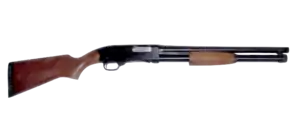 |
12 gauge, US Origin | ||
| Hand Grenades | ||||||
| RGD-5 | Hand grenade | Unknown |  |
Used alongside US made hand-grenades.[10] | ||
| M67 grenade | Hand grenade | Unknown |  |
[15] | ||
| Mk2 grenade | Hand grenade | Unknown |  |
[15] | ||
| Land Mines | ||||||
| M18A1 Claymore | Anti-personnel mine | Unknown |  |
[15] | ||
| Rocket Propelled Grenade Launchers | ||||||
| RPG-7 | Rocket Propelled Grenade | Unknown |  |
[10] | ||
| RPG-2 | Shoulder-fired Recoilless gun | Unknown | [10] | |||
| RPG-18 | Rocket Propelled Grenade | Unknown | 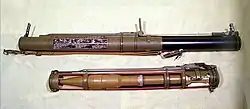 |
[16] | ||
| Type 56 RPG | Rocket Propelled Grenade | Unknown | [16] Chinese copy of RPG-2 | |||
| Type 69 RPG | Rocket Propelled Grenade | Unknown |  |
[16] Chinese copy of RPG-7 | ||
| M20A1B1 Super Bazooka | Rocket Propelled Grenade | Unknown | [10] | |||
| LRAC F1 | Shoulder-launched missile weapon | Unknown |  |
[10] | ||
Crew Served Weapons
| Name | Origin | Type | Quantity | Photo | Notes | |
|---|---|---|---|---|---|---|
| Recoilless Rifles | ||||||
| M67 recoilless rifle | Recoilless rifle | Unknown |  |
90mm Recoilless Rifle [10] | ||
| Type 52 | Recoilless rifle | Unknown |  |
Chinese copy of US 75mm M20 Recoilless Rifle.[10] | ||
| Mortars | ||||||
| M2 Mortar | Infantry Mortar | Unknown |  |
60mm Mortar [10] | ||
| Soltam C03 60mm Mortar | Infantry Mortar | Unknown |  |
60mm Mortar [10] | ||
| M29 Mortar | Infantry Mortar | Unknown | 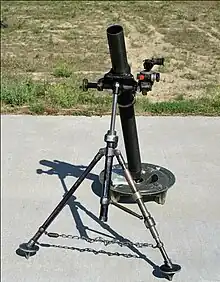 |
81mm Mortar [10] | ||
| M30 Mortar | Heavy Mortar | Unknown |  |
106.7mm Mortar [10] | ||
| M2 4.2-inch mortar | Heavy Mortar | Unknown |  |
106.7mm Mortar [16] | ||
| MO-120-RT | Heavy Mortar | Unknown |  |
120 mm Mortar [10] | ||
| Anti-Aircraft Guns | ||||||
| ZPU-4 | Anti-Aircraft Gun | ~20 |  |
14.5mm Anti-Aircraft gun [10] | ||
| ZPU-1 | Anti-Aircraft Gun | Unknown |  |
14.5mm Anti-Aircraft gun | ||
Less Lethal Weapons
| Name | Origin | Type | Quantity | Photo | Notes | |
|---|---|---|---|---|---|---|
| Less Lethal Weapons | ||||||
| Federal Riot Gun | Riot gun | Unknown |  |
38mm Tear gas gun | ||
| Federal Laboratories Model 515 Triple Chaser | Tear Gas | Unknown | A CS gas grenade that splits up into three parts upon deployment. | |||
Armoured Vehicles
| Name | Origin | Type | Quantity | Photo | Notes | |
|---|---|---|---|---|---|---|
| Armored Personnel Carriers | ||||||
| V-150 | Armored Personnel Carrier | ~17 |  |
4 Command Vehicles, and 13 Armored Personnel Carriers, Fitted with mounted 7.62mm Machine guns/and or Browning .50 Machine guns, also a '90' version with a 20mm cannon. | ||
| V-300 | Armored Personnel Carrier & Armoured recovery vehicle | 13 | 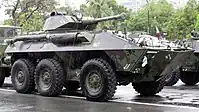 |
Multiple versions- APC versions, Recovery Versions, and a Fire Support Vehicle version fitted with Belgian Cockerel 90mm MK III gun and 7.62mm Machine guns. | ||
Unarmored Vehicles
| Name | Origin | Type | Quantity | Photo | Notes | |
|---|---|---|---|---|---|---|
| Utility Vehicles | ||||||
| M151 | Military light utility vehicle | Unknown | _GB_(owner_Gavin_Broad).JPG.webp) |
|||
| CUCV | Pickup Truck | Unknown |  |
[18] US Foreign Military Sales | ||
| M35 | Military truck | Unknown |  |
[19][18] 2+1⁄2-ton Truck | ||
| M809 | Military truck | Unknown |  |
[18] 5 ton Truck | ||
| Robur All Wheel Drive Truck | Truck | 32 |  |
In port of Balboa, Panama, 32 were confiscated from Danish Cargo ship 'Pia Vesta' originating from East German Port of Rostock in 1986, later found in Panama Defense Force service.[17][20] | ||
| M38A1 | Military light utility vehicle | 2 | .jpg.webp) |
[13] National Guard era, numbers are as of 1958 | ||
| M38 | Military light utility vehicle | 8 |  |
[13] National Guard era, numbers are as of 1958 | ||
| Willys MB/Ford GPW | Military light utility vehicle | 3 |  |
[13] National Guard era, numbers are as of 1958 | ||
| Landrover Series I | Military light utility vehicle | 6 |  |
[13] National Guard era, numbers are as of 1958 | ||
| Gurgel X12 | Truck | Unknown | _Classic-Days_2022_DSC_0107.jpg.webp) |
[21] | ||
Aircraft
Naval Vessels
| Name | Origin | Type | Quantity | Photo | Notes | |
|---|---|---|---|---|---|---|
| Ships | ||||||
| Landing Ship Medium (R) | Amphibious assault ship | 1 | 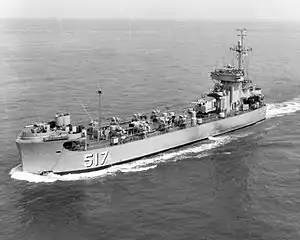 |
Former USS Smoky Hill River (LFR-531) [24] | ||
| Vosper Thornycroft 103 Foot, 96 ton Patrol Boat | Rough-Water Patrol Craft | 2 | GC10 Panquiaco and GC11 Ligia Elena, fitted with 2 20mm cannons each. 23 man complement.[25][21] | |||
| Unspecified 19 meter, 13 ton Utility Coastal Patrol Craft | Patrol Boat | 2 | Armed with a pair of 12.7mm machineguns each, 10 man complement. Transferred from the US Coast Guard in the mid-1960's.[25][21] | |||
| Unspecified 12 meter 35 ton Coastal Patrol Craft | Patrol Boat | 2 | Armed with 1 12.7mm machineguns each, 4 man complement. Transferred from the US Navy in the mid-1960's.[25][21] | |||
| Unspecified 35 Ton Swift Ships | Unspecified Vessel | 2 | MN GC-201 Comandante Torrijos and MN GC-202 Presidente Porras received in the 1980s and constructed in the USA.[25][21] | |||
References
- ↑ https://www.govinfo.gov/content/pkg/GOVPUB-D2-302e230a2f40d5f99e8f92c01255db62/pdf/GOVPUB-D2-302e230a2f40d5f99e8f92c01255db62.pdf
- ↑ https://www.globalsecurity.org/military/world/centam/pa-gn.htm
- 1 2 3 4 5 6 "Historia". www.policia.gob.pa (in Spanish). Retrieved 13 February 2020.
- ↑ Thomas, Donnelly (1992). Operation Just Cause. Lexington Books. p. 74. ISBN 0669249750.
- 1 2 3 4 "Panamanian Defense Forces Order of Battle". history.army.mil. Retrieved 19 February 2023.
- ↑ "Fuerza de Marina Nacional" (in Spanish).
- 1 2 "POR LA CUAL SE DICTA LA LEY ORGANICA DE LAS FUERZAS DE DEFENSA DE LA REPUBLICA DE PANAMA" (PDF). Gaceta Oficial de la República de Panamá. 30 September 1983. pp. 15–16.
- 1 2 Ropp, Steve C. (1989). "National Security". In Meditz, Sandra W.; Hanratty, Dennis M. (eds.). Panama: a country study. Area Handbook (4th ed.). Washington, D.C.: Library of Congress. p. 240. LCCN 88-600486. Retrieved 8 July 2022.
- ↑ Nyrop, Richard F. (1981). Panama: A Country Study. Department of the Army. p. 183.
- 1 2 3 4 5 6 7 8 9 10 11 12 13 14 15 16 17 18 19 20 21 22 23 24 25 26 27 28 29 30 31 32 33 34 35 36 Rottman, Gordon (2010). Panama 1989-90. Elite. Vol. 37. Osprey Publishing. pp. 14, 15, 57, 62, 63. ISBN 9781855321564.
- 1 2 3 4 5 6 7 Ezell, Edward (1988). Small Arms Today. Vol. 2nd. Stackpole Books. pp. 299–300. ISBN 0811722805.
- 1 2 Weeks, John (1980). Jane's Infantry Weapons 1980-1981. Infantry Weapons. Vol. Sixth. Jane's Publishing Company. p. 676. ISBN 0710607024.
- 1 2 3 4 5 6 7 8 9 10 11 12 13 14 15 Hardin, Herbert O.; Neely, J. (September 1958). "Report On The Police Forces Of The Republic Of Panama" (PDF). usaid.gov. International Cooperation Agency. Retrieved November 17, 2022.
- 1 2 "La Estrella De Panama". La Estrella De Panama. May 29, 2009. Archived from the original on November 17, 2022. Retrieved November 16, 2022.
- 1 2 3 4 5 Fundación de ParquesNacionales y Medio Ambiente (December 2015). Humanitarian Clearance of Contaminated withUXOs lands at Rio Hato Bombing & Firing Range, Cocle Province, Panama (PDF) (Report). Fundación de ParquesNacionales y Medio Ambiente. p. 16. Retrieved November 20, 2022.
- 1 2 3 4 5 6 7 8 9 10 11 12 13 Rottman, Gordon (2007). Just Cause 'Intervention in Panama 1989-90'. Concord Publications Company. pp. 4, 5. ISBN 978-9623616331.
- 1 2 3 4 Hill, Andrew (July 14, 2021). "1989 US Invasion of Panama". The Online Tank Museum. Retrieved October 30, 2022.
- 1 2 3 Foss, Christopher (ed.). "Jane's Military Logistics 1988". Jane's Military Logistics. Vol. Ninth Edition. Jane's Publishing Inc. pp. 520, 528, 532.
- ↑
"1989 US Invasion of Panama". NARA AND DVIDS PUBLIC DOMAIN ARCHIVES. January 1990. Retrieved October 30, 2022.
A Panamanian M-35 2.5-ton truck carrying members of 1ST Battalion, 509th Infantry, and their parachutes backs up to the loading ramp of a C-130E Hercules aircraft at the David airport. The soldiers parachuted into a drop zone outside the city to conduct operations in support of Operation Just Cause. Exact Date Shot Unknown
- ↑ "Star-Phoenix". Saskatoon, Saskatchewan, Canada. June 19, 1986. Retrieved November 17, 2022.
- 1 2 3 4 5 6 7 8 9 Schumacher, Rose (ed.). "Panama". World Defense Forces. Vol. Second Edition 1989. ABC Clio. p. 114.
- ↑ "World Air Forces 1975: Panama". Flight International. flightglobal.com. 28 August 1975. p. 307. Archived from the original on 4 April 2019. Retrieved 12 March 2013.
- ↑ "Panama Panamanian Air Force and National Navy". Countries of the World. 10 November 2004. Retrieved May 14, 2023.
External links
- https://panamadefenseforce.carrd.co/ A website containing a large amount of photographs of Panama Defense Forces troops.
- https://tanks-encyclopedia.com/1989-us-invasion-of-panama/ A website detailing operation just cause, with specific information on the PDF.
- https://history.army.mil/documents/panama/pdfob.htm US Military documentation of the Panama Defense Forces Order of Battle


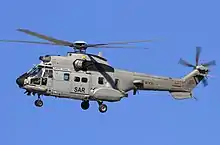
_225_Casa_C.212_Panama_Air_Force_(7488486058).jpg.webp)
.jpg.webp)

_arrives_at_RIAT_Fairford_12July2018_arp.jpg.webp)
.jpg.webp)
_Lofting.jpg.webp)



.jpg.webp)
%252C_Luxembourg_PP1278001849.jpg.webp)